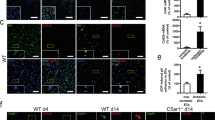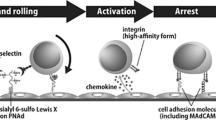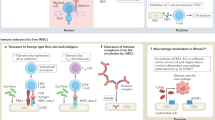Abstract
Circulating lymphocytes continuously enter lymph nodes for immune surveillance through specialized blood vessels named high endothelial venules1,2,3,4,5, a process that increases markedly during immune responses. How high endothelial venules (HEVs) permit lymphocyte transmigration while maintaining vascular integrity is unknown. Here we report a role for the transmembrane O-glycoprotein podoplanin (PDPN, also known as gp38 and T1α)6,7,8 in maintaining HEV barrier function. Mice with postnatal deletion of Pdpn lost HEV integrity and exhibited spontaneous bleeding in mucosal lymph nodes, and bleeding in the draining peripheral lymph nodes after immunization. Blocking lymphocyte homing rescued bleeding, indicating that PDPN is required to protect the barrier function of HEVs during lymphocyte trafficking. Further analyses demonstrated that PDPN expressed on fibroblastic reticular cells7, which surround HEVs, functions as an activating ligand for platelet C-type lectin-like receptor 2 (CLEC-2, also known as CLEC1B)9,10. Mice lacking fibroblastic reticular cell PDPN or platelet CLEC-2 exhibited significantly reduced levels of VE-cadherin (also known as CDH5), which is essential for overall vascular integrity11,12, on HEVs. Infusion of wild-type platelets restored HEV integrity in Clec-2-deficient mice. Activation of CLEC-2 induced release of sphingosine-1-phosphate13,14 from platelets, which promoted expression of VE-cadherin on HEVs ex vivo. Furthermore, draining peripheral lymph nodes of immunized mice lacking sphingosine-1-phosphate had impaired HEV integrity similar to Pdpn- and Clec-2-deficient mice. These data demonstrate that local sphingosine-1-phosphate release after PDPN–CLEC-2-mediated platelet activation is critical for HEV integrity during immune responses.
This is a preview of subscription content, access via your institution
Access options
Subscribe to this journal
Receive 51 print issues and online access
$199.00 per year
only $3.90 per issue
Buy this article
- Purchase on Springer Link
- Instant access to full article PDF
Prices may be subject to local taxes which are calculated during checkout




Similar content being viewed by others
References
Butcher, E. C. & Picker, L. J. Lymphocyte homing and homeostasis. Science 272, 60–67 (1996)
Drayton, D. L., Liao, S., Mounzer, R. H. & Ruddle, N. H. Lymphoid organ development: from ontogeny to neogenesis. Nature Immunol. 7, 344–353 (2006)
Girard, J. P., Moussion, C. & Forster, R. HEVs, lymphatics and homeostatic immune cell trafficking in lymph nodes. Nature Rev. Immunol. 12, 762–773 (2012)
Rosen, S. D. Ligands for l-selectin: homing, inflammation, and beyond. Annu. Rev. Immunol. 22, 129–156 (2004)
von Andrian, U. H. & Mempel, T. R. Homing and cellular traffic in lymph nodes. Nature Rev. Immunol. 3, 867–878 (2003)
Breiteneder-Geleff, S. et al. Podoplanin, novel 43-kd membrane protein of glomerular epithelial cells, is down-regulated in puromycin nephrosis. Am. J. Pathol. 151, 1141–1152 (1997)
Farr, A. G. et al. Characterization and cloning of a novel glycoprotein expressed by stromal cells in T-dependent areas of peripheral lymphoid tissues. J. Exp. Med. 176, 1477–1482 (1992)
Fu, J. et al. Endothelial cell O-glycan deficiency causes blood/lymphatic misconnections and consequent fatty liver disease in mice. J. Clin. Invest. 118, 3725–3737 (2008)
Bertozzi, C. C. et al. Platelets regulate lymphatic vascular development through CLEC-2-SLP-76 signaling. Blood 116, 661–670 (2010)
Watson, S. P., Herbert, J. M. & Pollitt, A. Y. GPVI and CLEC-2 in hemostasis and vascular integrity. J. Thromb. Haemost. 8, 1456–1467 (2010)
Carmeliet, P. et al. Targeted deficiency or cytosolic truncation of the VE-cadherin gene in mice impairs VEGF-mediated endothelial survival and angiogenesis. Cell 98, 147–157 (1999)
Grazia Lampugnani, M. et al. Contact inhibition of VEGF-induced proliferation requires vascular endothelial cadherin, β-catenin, and the phosphatase DEP-1/CD148. J. Cell Biol. 161, 793–804 (2003)
Camerer, E. et al. Sphingosine-1-phosphate in the plasma compartment regulates basal and inflammation-induced vascular leak in mice. J. Clin. Invest. 119, 1871–1879 (2009)
Gaengel, K. et al. The sphingosine-1-phosphate receptor S1PR1 restricts sprouting angiogenesis by regulating the interplay between VE-cadherin and VEGFR2. Dev. Cell 23, 587–599 (2012)
Soderberg, K. A. et al. Innate control of adaptive immunity via remodeling of lymph node feed arteriole. Proc. Natl Acad. Sci. USA 102, 16315–16320 (2005)
Goerge, T. et al. Inflammation induces hemorrhage in thrombocytopenia. Blood 111, 4958–4964 (2008)
Renz, H., Brandtzaeg, P. & Hornef, M. The impact of perinatal immune development on mucosal homeostasis and chronic inflammation. Nature Rev. Immunol. 12, 9–23 (2012)
Chyou, S. et al. Fibroblast-type reticular stromal cells regulate the lymph node vasculature. J. Immunol. 181, 3887–3896 (2008)
May, F. et al. CLEC-2 is an essential platelet-activating receptor in hemostasis and thrombosis. Blood 114, 3464–3472 (2009)
Gallatin, W. M., Weissman, I. L. & Butcher, E. C. A cell-surface molecule involved in organ-specific homing of lymphocytes. Nature 304, 30–34 (1983)
Diacovo, T. G. et al. Platelet-mediated lymphocyte delivery to high endothelial venules. Science 273, 252–255 (1996)
Dejana, E., Tournier-Lasserve, E. & Weinstein, B. M. The control of vascular integrity by endothelial cell junctions: molecular basis and pathological implications. Dev. Cell 16, 209–221 (2009)
Hodivala-Dilke, K. M. et al. β3-integrin-deficient mice are a model for Glanzmann thrombasthenia showing placental defects and reduced survival. J. Clin. Invest. 103, 229–238 (1999)
Ulrych, T. et al. Release of sphingosine-1-phosphate from human platelets is dependent on thromboxane formation. J. Thromb. Haemost. 9, 790–798 (2011)
Pappu, R. et al. Promotion of lymphocyte egress into blood and lymph by distinct sources of sphingosine-1-phosphate. Science 316, 295–298 (2007)
Gretz, J. E., Anderson, A. O. & Shaw, S. Cords, channels, corridors and conduits: critical architectural elements facilitating cell interactions in the lymph node cortex. Immunol. Rev. 156, 11–24 (1997)
Katakai, T. et al. Lymph node fibroblastic reticular cells construct the stromal reticulum via contact with lymphocytes. J. Exp. Med. 200, 783–795 (2004)
Boulaftali, Y. et al. Platelet ITAM signaling is critical for vascular integrity in inflammation. J. Clin. Invest. 123, 908–916 (2013)
Hayashi, S. & McMahon, A. P. Efficient recombination in diverse tissues by a tamoxifen-inducible form of Cre: a tool for temporally regulated gene activation/inactivation in the mouse. Dev. Biol. 244, 305–318 (2002)
Foo, S. S. et al. Ephrin-B2 controls cell motility and adhesion during blood-vessel-wall assembly. Cell 124, 161–173 (2006)
Kisanuki, Y. Y. et al. Tie2-Cre transgenic mice: a new model for endothelial cell-lineage analysis in vivo. Dev. Biol. 230, 230–242 (2001)
Mombaerts, P. et al. RAG-1-deficient mice have no mature B and T lymphocytes. Cell 68, 869–877 (1992)
Han, E. D. et al. Increased vascular permeability in C1 inhibitor-deficient mice mediated by the bradykinin type 2 receptor. J. Clin. Invest. 109, 1057–1063 (2002)
Kamala, T. Hock immunization: a humane alternative to mouse footpad injections. J. Immunol. Methods 328, 204–214 (2007)
Lou, J. et al. Flow-enhanced adhesion regulated by a selectin interdomain hinge. J. Cell Biol. 174, 1107–1117 (2006)
Xia, L. et al. P-selectin glycoprotein ligand-1-deficient mice have impaired leukocyte tethering to E-selectin under flow. J. Clin. Invest. 109, 939–950 (2002)
Bergmeier, W. et al. Flow cytometric detection of activated mouse integrin αIIbβ3 with a novel monoclonal antibody. Cytometry 48, 80–86 (2002)
Selim, S. et al. Plasma levels of sphingosine 1-phosphate are strongly correlated with haematocrit, but variably restored by red blood cell transfusions. Clin. Sci. 121, 565–572 (2011)
Acknowledgements
We thank P. Kincade and L. Thompson for critical reading of the manuscript; R. Adams for providing PdgfrbCre mice; and M. Kinter and M.C. Marlin for technical assistance. Work was supported by grants from the National Institutes of Health (GM103441, GM097747, HL085607, HL093242, HL103432, HL065590, HL112788), VA Merit Award (BX001984), the American Heart Association (SDG7410022), the Deutsche Forschungsgemeinschaft (SFB688), National Natural Science Foundation of China (30928010), Jiangsu Provincial Special Program of Medical Science (BL2012005) and Jiangsu Province’s Key Medical Center (ZX201102).
Author information
Authors and Affiliations
Contributions
B.H.H. and J.F. designed and performed experiments, analysed results and drafted the manuscript. J.M.M., Y.P., M.S., T.Y., R.S.-M., S.M., A.J.M. and F.L. performed experiments. S.J.W., P.R.H., A.S., F.M., B.N. and S.R.C. supplied key reagents and mice. R.P.M., H.C. and M.L.K. helped analyse results and commented on the manuscript. L.X. designed and supervised research and wrote the manuscript.
Corresponding author
Ethics declarations
Competing interests
The authors declare no competing financial interests.
Supplementary information
Supplementary Figures
This file contains Supplementary Figures 1-18. (PDF 1614 kb)
Rights and permissions
About this article
Cite this article
Herzog, B., Fu, J., Wilson, S. et al. Podoplanin maintains high endothelial venule integrity by interacting with platelet CLEC-2. Nature 502, 105–109 (2013). https://doi.org/10.1038/nature12501
Received:
Accepted:
Published:
Issue Date:
DOI: https://doi.org/10.1038/nature12501
This article is cited by
-
Reduction in disialyl-T antigen levels in mice deficient for both St6galnac3 and St6galnac4 results in blood filling of lymph nodes
Scientific Reports (2023)
-
Biomarker and genomic analyses reveal molecular signatures of non-cardioembolic ischemic stroke
Signal Transduction and Targeted Therapy (2023)
-
Splenic stromal niches in homeostasis and immunity
Nature Reviews Immunology (2023)
-
Emergent surgical evacuation of traumatic intracranial hematoma in patients with preoperative thrombocytopenia: surgical risk and early outcome
Acta Neurologica Belgica (2023)
-
Platelets involved tumor cell EMT during circulation: communications and interventions
Cell Communication and Signaling (2022)
Comments
By submitting a comment you agree to abide by our Terms and Community Guidelines. If you find something abusive or that does not comply with our terms or guidelines please flag it as inappropriate.



